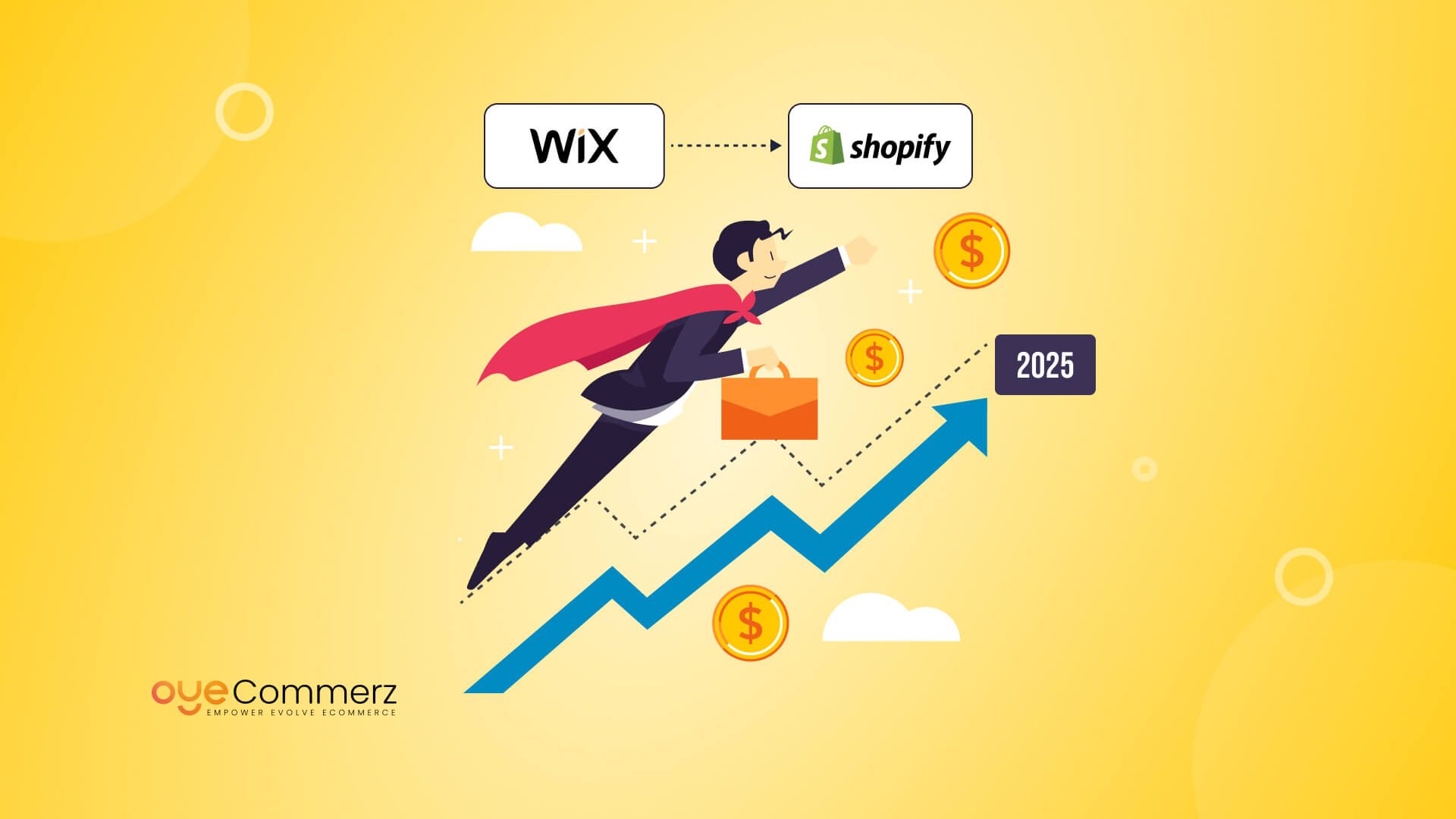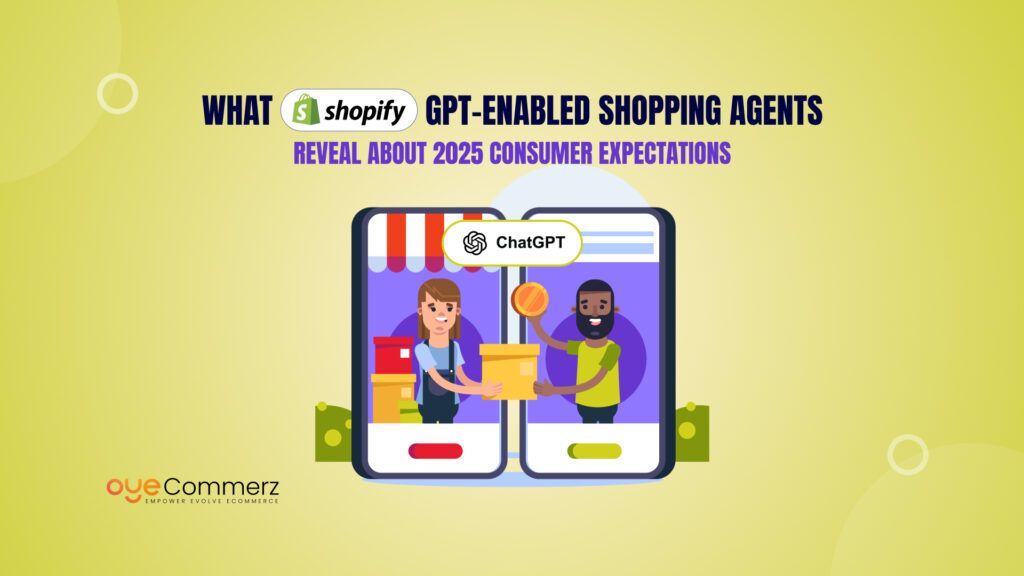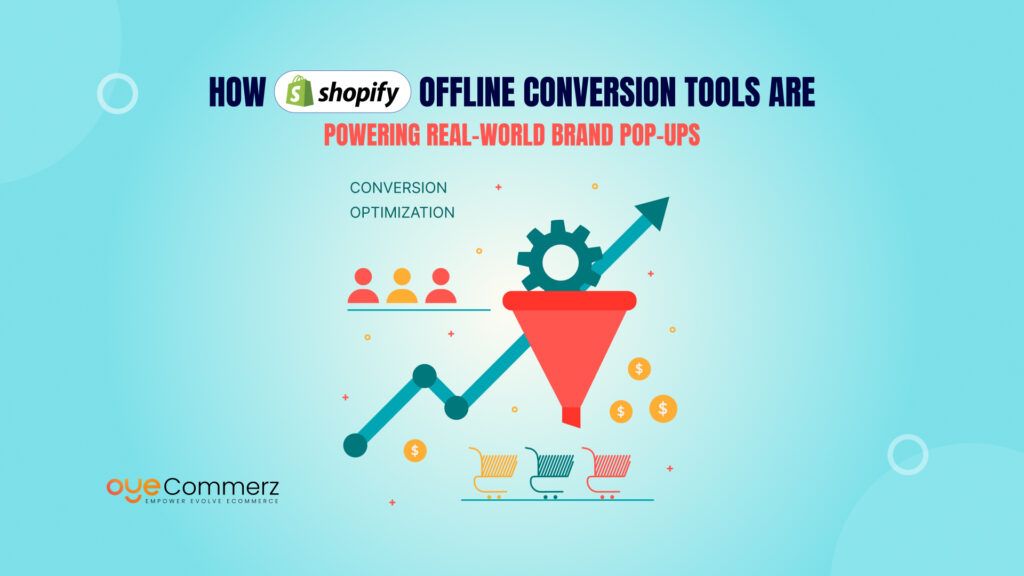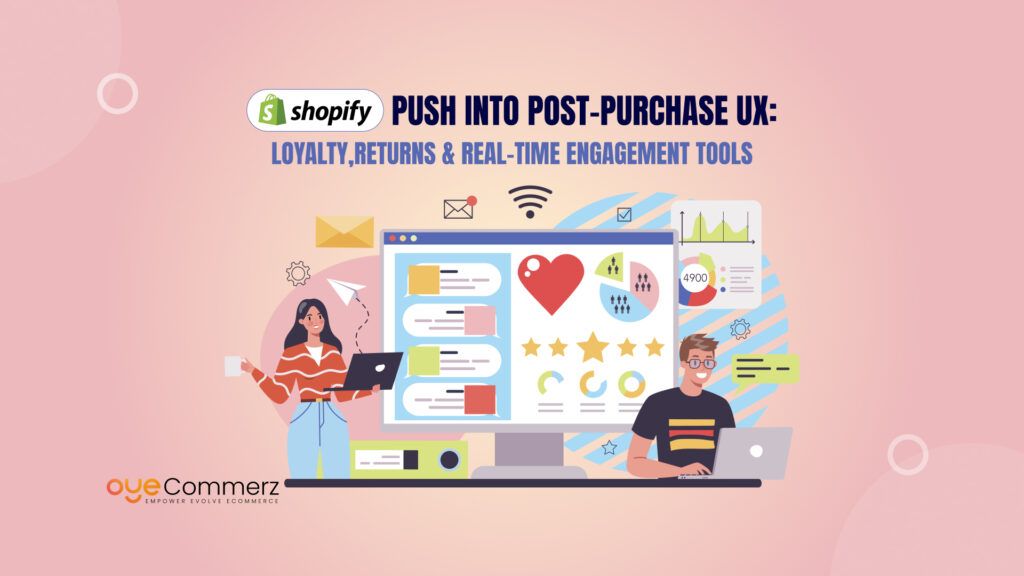Is your current e-commerce platform holding you back from reaching your full sales potential? Businesses that switch from Wix to Shopify often see an increase in revenue by up to 30%—thanks to Shopify’s advanced features, seamless checkout process, and better scalability.
As an existing Shopify business owner, you already understand the power of a well-optimized online store. But if you’ve ever struggled with platform limitations, slow loading speeds, or limited app development options, you’re not alone. That’s why more brands are making the move from Wix to Shopify—to unlock greater growth, better customer experiences, and higher conversions.
In this blog, we’ll break down why migrating from Wix to Shopify in 2025 is the smartest decision for scaling your business and maximizing sales. Let’s dive in!
Table of Contents
ToggleThe Cost of Staying on Wix: Are You Leaving Sales on the Table?
If you’re still running your online store on Wix, it’s time to ask yourself a serious question: Are you truly maximizing your sales potential? While Wix may seem like an easy-to-use platform for beginners, its limitations often prevent businesses from reaching their full revenue potential. Commanding over 10% of the global e-commerce market, Shopify’s extensive reach and reliability make it a formidable platform for online businesses.
1. Lack of Advanced E-commerce Tools
Wix was originally designed as a website builder, not a dedicated e-commerce platform. As a result, its suite of e-commerce tools often lacks the depth required to meet the needs of growing businesses. Features like abandoned cart recovery, product recommendations, and detailed customer analytics are either basic or unavailable. These missing features are critical for:
- Increasing cart value through upselling and cross-selling.
- Understanding customer behavior to refine your marketing strategies.
- Recovering lost sales from customers who didn’t complete their checkout.
Without these tools, your ability to drive consistent sales and grow revenue is significantly limited.
2. Slower Page Speeds That Affect Conversions
Did you know that page load speed is directly tied to conversion rates? Research shows that a one-second delay in load time can reduce conversions by up to 7%. Unfortunately, Wix stores often suffer from slower loading speeds due to limited optimization options. This impacts:
- Customer experience: Visitors are likelier to leave a site that takes too long to load.
- SEO performance: Search engines like Google penalize slower websites, reducing your store’s visibility.
A slow site means fewer visitors convert into customers, directly hitting your bottom line.
3. SEO Challenges That Limit Your Store’s Visibility
One of the biggest drawbacks of Wix is its limited SEO capabilities compared to platforms like Shopify. Wix lacks flexibility in URL structures, metadata editing, and advanced SEO features, which makes it harder to rank your store on search engines. Lower visibility means:
- Fewer organic visitors to your store.
- A higher reliance on paid ads to generate traffic increases costs.
In today’s competitive e-commerce landscape, being invisible on search engines is a surefire way to lose sales.
4. Limited Third-Party Integrations for Marketing and Analytics
Effective e-commerce growth relies heavily on third-party tools for marketing, analytics, and customer engagement. While Wix does offer some integrations, its ecosystem is far less robust than Shopify’s. Missing out on these integrations means:
- Limited automation for email marketing campaigns.
- Poor tracking of customer behavior and sales funnel insights.
- Inability to leverage advanced advertising strategies on platforms like Facebook and Google.
Without access to these tools, scaling your marketing efforts becomes a challenge. Your store’s sales potential remains capped.
How These Issues Translate to Lost Revenue
When you combine slower load speeds, poor SEO, and limited e-commerce features, the result is clear:
- Fewer customers find your store.
- Even fewer complete a purchase.
- Revenue growth stagnates.
Here’s a breakdown of the revenue impact:
By sticking to Wix, you’re not just limiting your current revenue—you’re also missing out on the explosive growth potential that can advance your e-commerce platform.
The Solution: Transitioning to Shopify
The good news is that Wix to Shopify migration offers a way out of these limitations. Shopify, with its advanced tools and integrations, empowers businesses to:
- Deliver a faster, seamless shopping experience.
- Rank higher on search engines with robust SEO features.
- Maximize sales with abandoned cart recovery and upselling functionalities.
- Scale effortlessly with access to thousands of third-party apps.
Why Shopify is Built to Supercharge Your Sales
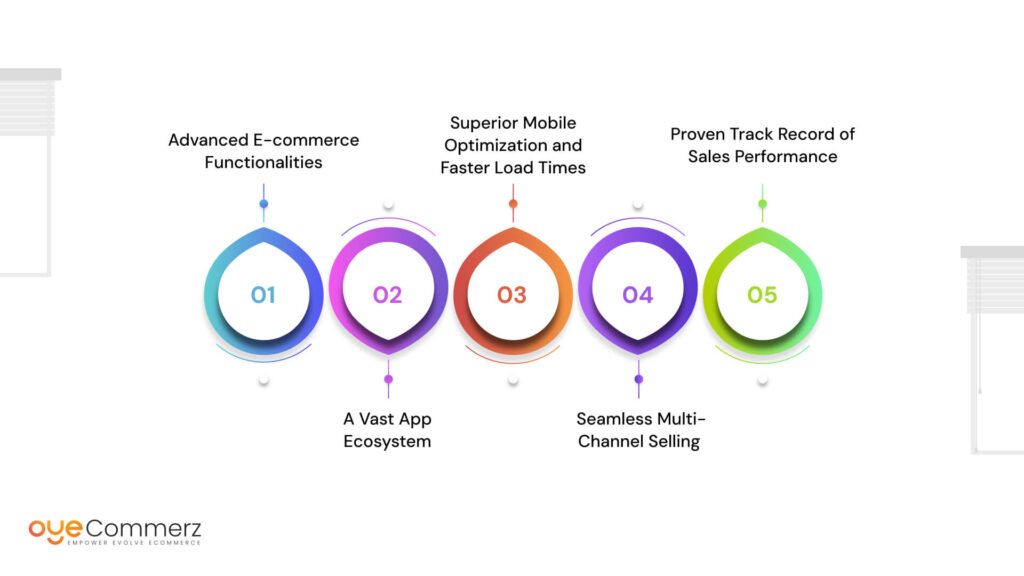
When maximizing your e-commerce potential, Shopify stands head and shoulders above Wix. Whether you’re an established store owner or just starting your journey, Shopify offers advanced features and tools designed to boost revenue and improve customer experience. With access to over 8,000 apps, Shopify provides a vast ecosystem allowing merchants to enhance their store’s functionality, surpassing Wix’s offering of around 500 third-party apps. Here’s why migrating from Wix to Shopify can supercharge your sales in 2025.
1. Advanced E-commerce Functionalities
Unlike Wix, Shopify was built from the ground up for e-commerce, making it the go-to platform for online businesses aiming for growth. Some standout features include:
- Abandoned Cart Recovery: Shopify automatically sends follow-up emails to customers who didn’t complete their purchases, helping you recovereffortlessly recover lost sales
- Cross-Selling Tools: Offer personalized product recommendations and bundles to increase your average order value.
- Integrated Analytics: Shopify provides actionable insights into customer behavior, helping you refine your marketing strategies.
These tools work in harmony to help you:
- Convert more visitors into paying customers.
- Increase revenue per transaction.
- Build long-term customer relationships.
2. A Vast App Ecosystem
Shopify’s app marketplace is unmatched in its variety and depth. With over 6,000 apps, you can find tools for:
- Automating marketing campaigns.
- Enhancing customer experience with features like live chat and loyalty programs.
- Managing inventory across multiple channels.
Each app is designed to integrate seamlessly with your store, saving you time while helping you optimize every step of the customer journey.
3. Superior Mobile Optimization and Faster Load Times
Mobile shopping continues to dominate in 2025, and Shopify ensures your store is ready for the challenge.
- Mobile-Responsive Themes: Shopify’s themes are designed to look great on any device, ensuring a seamless shopping experience.
- Faster Load Times: Shopify outperforms Wix regarding page speed, reducing bounce rates and improving conversions.
A faster, mobile-friendly site means more customers stay, shop, and return.
4. Seamless Multi-Channel Selling
Shopify allows you to sell everywhere your customers are, including:
- Social Media Platforms: Instagram, Facebook, TikTok.
- Marketplaces: Amazon, eBay.
- In-Person Sales: With Shopify’s POS system for retail stores and pop-up events.
This multi-channel approach ensures that your products are accessible wherever your audience prefers to shop, significantly increasing your sales opportunities.
5. Proven Track Record of Sales Performance
Shopify’s focus on e-commerce has translated into real results for businesses:
- Stores on Shopify see higher average conversion rates than those on Wix.
- Faster page speeds and better SEO tools mean more organic traffic and improved customer retention.
- Shopify merchants conerate billions in sales annually, a testament to the platform’s capability to drive growth.
Wix vs. Shopify: Which One Truly Maximizes Sales Potential?
When evaluating e-commerce platforms, every business owner must ask: Which platform will help me generate the most revenue? For Wix users struggling with the limitations of a general-purpose website builder, Shopify offers a dedicated, scalable solution specifically designed to maximize sales. Let’s dive into a detailed feature-by-feature comparison to understand why Shopify outshines Wix in driving sales growth.
1. Page Load Speed: Shopify Wins in Performance
One of the most critical factors influencing online sales is page load speed. Studies show that a delay of just one second can decrease conversions by up to 7%, while 53% of mobile users abandon a site that takes longer than three seconds to load.
- Wix:
- Built for general website purposes, Wix struggles with page speed optimization, especially for image-heavy or product-laden e-commerce sites.
- Slower loading speeds often lead to higher bounce rates, which translates to lost sales opportunities.
- Shopify:
- Optimized for e-commerce, Shopify delivers faster load times, even for large product catalogs.
- Shopify themes are built with performance in mind, ensuring your site loads quickly on both desktop and mobile devices.
Impact: Faster load times improve the customer experience and enhance your SEO ranking, bringing in more organic traffic.
2. SEO Performance: Shopify Provides Advanced Features
Search engine optimization (SEO) is a cornerstone of driving organic traffic and boosting sales. While Wix offers basic SEO tools, Shopify’s SEO capabilities are far more advanced.
- Wix:
- Provides simple tools for editing titles, meta descriptions, and alt text.
- URL structures are less flexible, which can negatively impact search engine rankings.
- Shopify:
- Includes advanced SEO features such as customizable URLs, faster page speeds, and automated sitemap generation.
- Optimized for Google Shopping and search engine crawlers, helping your store rank higher in search results.
Impact: With better SEO tools, Shopify ensures your products are visible to potential customers, driving more organic sales.
3. Marketing Integrations: Shopify Delivers Comprehensive Solutions
Effective marketing integrations can make or break your ability to reach customers and drive sales. Here’s how Wix and Shopify stack up:
- Wix:
- Limited integration options for tools like email marketing, ad platforms, and automation software.
- Heavily reliant on third-party apps that don’t always integrate smoothly.
- Shopify:
- Offers a robust ecosystem of marketing tools, from email campaigns to retargeting ads on Facebook, Google, and TikTok.
- Seamlessly integrates with over 6,000 apps designed to enhance every stage of the sales funnel.
Impact: With Shopify, you can run powerful marketing campaigns that increase traffic and conversions without the technical headaches.
4. Payment Flexibility: Shopify Ensures Fewer Abandoned Carts
Offering customers flexible payment options is essential for reducing abandoned carts and closing sales. Here’s how each platform handles payments:
- Wix:
- It supports basic payment gateways, but the range is limited compared to Shopify.
- Lacks advanced options like local payment methods and multi-currency support.
- Shopify:
- It supports Shopify Payments and hundreds of third-party gateways.
- Features multi-currency options, local payment methods, and integrations with popular services like PayPal, Apple Pay, and Google Pay.
Impact: With more payment options, Shopify ensures that customers complete their transactions, regardless of where they prefer to pay.
5. Scalability: Shopify Grows With Your Business
As your business grows, your platform needs to keep up. Wix’s scalaed, mak scalability makes less viable option for high-growth e-commerce businesses.
- Wix:
- Best suited for smaller stores with limited product offerings.
- Performance and functionality tend to decline as your store expands.
- Shopify:
- Built to handle large product catalogs, high traffic volumes, and complex operations.
- Offers enterprise solutions like Shopify Plus for businesses aiming for global reach.
Impact: Shopify allows you to scale effortlessly, ensuring your platform grows alongside your business without compromising performance.
The Secret Sauce: Shopify Tools That Turbocharge Your Sales
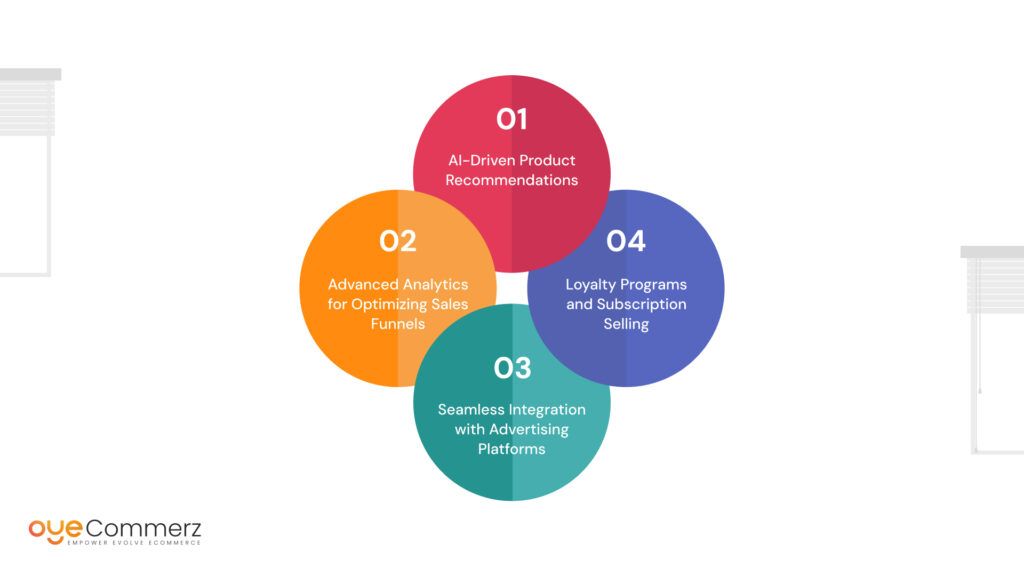
When you migrate from Wix to Shopify, you’re not just switching platforms—you’re unlocking a suite of powerful tools designed to drive sales and fuel growth. Shopify goes beyond the basics of running an online store by offering advanced features that create a seamless, conversion-focused shopping experience. With a user base exceeding 4 million and a 25% market share, Shopify leads the e-commerce platform industry, highlighting its widespread adoption and trust among online retailers. Let’s explore the tools that make Shopify the ultimate sales engine.
1. AI-Driven Product Recommendations
Shopify’s AI-driven product recommendation tools are designed to increase the average order value by encouraging customers to add more items to their carts. These tools use data like customer purchase history and browsing behavior to provide personalized suggestions.
- Upselling and Cross-Selling: Recommend higher-value products or complementary items to customers during checkout.
- Dynamic Personalization: Display suggestions tailored to each customer’s preferences, increasing the likelihood of a purchase.
Impact: These recommendations create a more engaging shopping experience and significantly boost revenue per transaction.
2. Advanced Analytics for Optimizing Sales Funnels
Data-driven decision-making is at the heart of e-commerce success, and Shopify provides the tools you need to optimize every stage of your sales funnel.
- Customer Insights: Understand buying patterns, preferences, and demographics.
- Sales Reports: Track your store’s performance with detailed analytics on revenue, traffic sources, and conversion rates.
- Behavior Analysis: Identify drop-off points in the customer journey and take steps to address them.
Impact: You can fine-tune your strategies to improve conversions and customer retention with these insights.
3. Seamless Integration with Advertising Platforms
Shopify makes it easy to amplify your store’s visibility through targeted advertising campaigns. Its integrations with platforms like Facebook, Google, and TikTok allow you to:
- Create Dynamic Ads: Automatically sync your product catalog with ad platforms to show the right products to customers.
- Track ROI: Measure the success of each campaign with Shopify’s built-in ad reporting tools.
- Leverage Retargeting: Re-engage visitors who left without purchasing retargeted ads.
Impact: By simplifying ad management, Shopify ensures your marketing budget is spent effectively, driving more traffic and conversions.
4. Loyalty Programs and Subscription Selling
Keeping customers engaged and encouraging repeat purchases is crucial for sustained growth. Shopify supports loyalty programs and subscription selling, enabling you to:
- Reward Customer Loyalty: Offer repeat buyers discounts, points, or exclusive perks.
- Sell Subscriptions: Provide customers with the convenience of recurring orders for products they love.
- Automate Engagement: Use email and SMS notifications to remind customers about their rewards or subscription renewals.
Impact: Building customer loyalty translates into higher lifetime value and consistent revenue growth.
The Migration Opportunity: Unlocking Hidden Revenue Potential
In today’s competitive e-commerce landscape, sticking with Wix can prevent your business from achieving its full potential. Migrating to Shopify isn’t just an upgrade—it’s a strategic move to unlock untapped revenue streams and future-proof your business for 2025 and beyond.
1. Shifting Consumer Expectations
Consumers in 2025 expect fast, seamless, and personalized shopping experiences. Unfortunately, Wix’s limitations often fail to meet these expectations:
- Slower Speeds: Customers are quick to leave a slow-loading site.
- Limited Features: A lack of advanced tools for personalization and convenience impacts customer satisfaction.
On the other hand, Shopify is designed to cater to the demands of modern shoppers. With fast load times, personalized recommendations, and multi-channel selling capabilities, Shopify helps you stand out in a crowded market.
2. Increased Competition in E-commerce
As more businesses enter the online space, standing out becomes harder. Sticking with a platform like Wix, which offers limited scalability and fewer growth-oriented tools, puts you at a disadvantage.
Migrating to Shopify gives you:
- Access to advanced marketing tools to attract and retain customers.
- A professional, sleek store design that builds trust.
- The ability to scale operations effortlessly as your business grows.
Impact: Shopify provides the edge you need to thrive in a highly competitive market.
3. Shopify’s Ongoing Innovations
Shopify continuously invests in its platform, ensuring you have access to cutting-edge tools and features. From AI-powered analytics to seamless integrations with the latest technologies, Shopify ensures your store is always ahead of the curve.
Impact: By migrating to Shopify, you’re not just catching up but staying ahead of the competition.
Challenges of Migration: What’s Holding You Back?
Migrating your online store from Wix to Shopify might sound daunting, but understanding the common challenges can help you confidently navigate the process. Let’s address these concerns:
1. Fear of Losing SEO Rankings or Customer Data
One of the biggest worries for Wix users is the potential loss of search engine rankings during migration. SEO is a critical driver of organic traffic; losing your rankings could mean a drop in visibility. The fear of losing customer data—such as purchase history and email addresses—can also feel overwhelming.
Solution: A well-planned migration ensures that your URLs are redirected properly, preserving your SEO rankings. Shopify also allows for seamless data import, ensuring your customer and order history remain intact.
2. Concerns About Downtime and Sales Disruption
Many store owners worry about downtime during migration, which could lead to lost sales and frustrated customers.
Solution: With a structured migration plan, downtime can be minimized or even eliminated. A staging environment allows you to test your Shopify store before it goes live, ensuring a smooth transition.
3. Perceived Complexity of Migration
The migration process can feel overwhelming, especially for those without technical expertise, from transferring product catalogs to setting up payment gateways.
Solution: Shopify’s intuitive interface and support documentation makes setting up your store easy. Alternatively, hiring an expert migration partner ensures that every step is handled professionally and efficiently.
How Oyecommerz Makes Migration Seamless and Sales-Focused
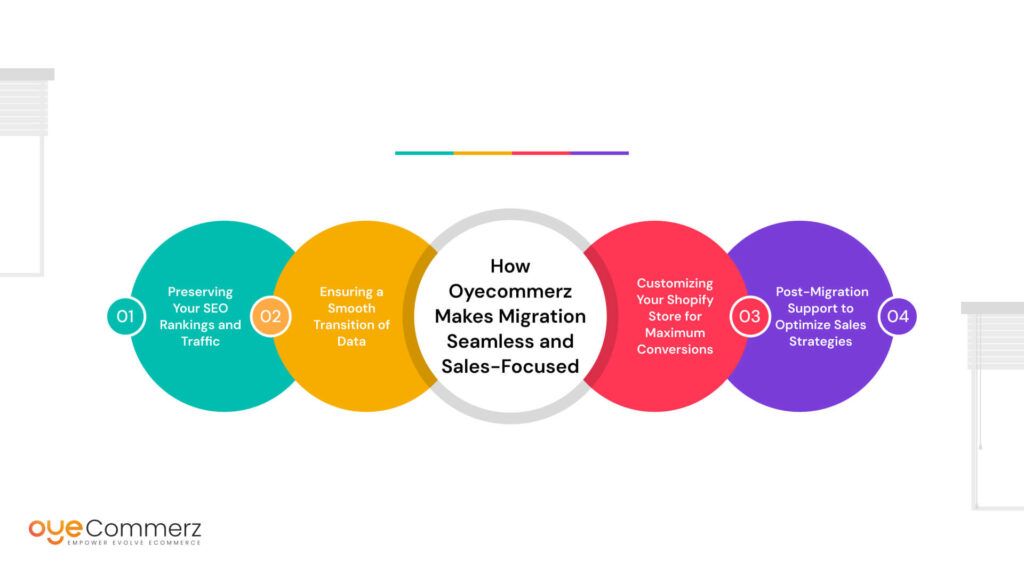
Migrating from Wix to Shopify can seem daunting, but with the right partner, the process becomes seamless, efficient, and tailored to your business’s needs. This is where Oyecommerz comes in. As a trusted migration expert, Oyecommerz ensures a smooth transition and optimizes your new Shopify store to drive sales and growth.
Here’s how Oyecommerz transforms the migration process into a strategic upgrade for your business.
1. Preserving Your SEO Rankings and Traffic
One of the most significant concerns during migration is the potential loss of search engine rankings, which can directly impact your store’s visibility and revenue. Oyecommerz ensures this doesn’t happen by implementing a thorough SEO migration strategy.
- URL Redirection: We map and redirect your existing URLs to their new Shopify counterparts to maintain search engine rankings.
- Meta Tags and Keywords: All your meta titles, descriptions, and keywords are carefully migrated and optimized for Shopify’s advanced SEO tools.
- Site Structure Optimization: Shopify’s cleaner and more flexible URL structure is leveraged to improve SEO performance post-migration.
Impact: With Oyecommerz, your SEO rankings remain intact, and your store benefits from Shopify’s superior SEO capabilities.
2. Ensuring a Smooth Transition of Data
Migrating your product catalog, customer information, and order history can feel overwhelming, but Oyecommerz has the expertise to make it effortless.
- Product Data Migration: All product details, including descriptions, images, and categories, are transferred accurately.
- Customer Data Migration: Customer profiles, purchase history, and email lists are securely migrated to Shopify.
- Order Data Migration: Your order history is preserved, ensuring continuity in customer support and reporting.
Impact: By handling every detail, Oyecommerz ensures no valuable data is lost during migration.
3. Customizing Your Shopify Store for Maximum Conversions
A generic Shopify store isn’t enough to drive explosive revenue growth. Oyecommerz tailors your store’s design and functionality to align with your brand and maximize conversions.
- Theme Customization: We design a visually appealing, user-friendly store that reflects your brand’s identity.
- App Integration: Relevant Shopify apps are integrated to enhance your store’s functionality and sales performance.
- Conversion Optimization: Features like product recommendations, streamlined checkouts, and upselling tools are implemented to boost sales.
Impact: Your Shopify store isn’t just migrated—it’s optimized to outperform your previous platform in every way.
4. Post-Migration Support to Optimize Sales Strategies
The migration process doesn’t end when your Shopify store goes live. Oyecommerz offers ongoing support to ensure your store operates smoothly and continues to grow.
- Performance Monitoring: We analyze your store’s performance and make recommendations for improvement.
- Staff Training: Your team is trained on Shopify’s interface, ensuring they can manage the store efficiently.
- Sales Strategy Optimization: Insights and tools are provided to help you maximize your revenue potential.
Impact: With continuous support, you can focus on growing your business while Oyecommerz ensures your Shopify store runs like a well-oiled machine.
Why Choose Oyecommerz for Your Wix to Shopify Migration?
Migrating from Wix to Shopify can be a game-changer for your e-commerce business, but only if done correctly. A poorly managed migration can lead to data loss, broken URLs, SEO issues, and downtime, all of which can hurt your revenue. That’s why choosing the right migration partner is crucial.
At Oyecommerz, we specialize in seamless Wix to Shopify migrations, ensuring a smooth transition with zero disruptions to your business. Our expert team handles everything—from product and customer data transfer to design replication, SEO preservation, and app integrations—so you can focus on growing your store.
What Makes Oyecommerz the Best Choice?
100% Data Accuracy & Security – We ensure that all your products, orders, customer data, and content move securely from Wix to Shopify without errors.
SEO Preservation – We implement 301 redirects, maintain meta tags, and optimize URLs so your rankings remain intact after migration.
Custom Theme & Design Matching – Whether you want to replicate your Wix store’s look or go for a fresh Shopify design, we tailor the store to match your brand identity.
Seamless App Integration – Our team helps you find and integrate the best Shopify apps to enhance your store’s functionality.
Minimal Downtime & Quick Turnaround – We ensure a fast and efficient migration process, minimizing disruption to your business operations.
Future-Proof Your Store with Oyecommerz
Moving from Wix to Shopify isn’t just about switching platforms—it’s about unlocking better scalability, advanced features, and higher growth potential. Oyecommerz helps you maximize Shopify’s capabilities so you can build a powerful, high-converting e-commerce store.
Let’s Take Your Store to the Next Level with OyeCommerz!
Are you ready to unlock the full potential of your e-commerce business? Don’t let the limitations of Wix hold you back any longer. With Oyecommerz, your migration to Shopify will be smooth, strategic, and focused on driving sales.
Contact us today for a free consultation and take the first step toward explosive revenue growth in 2025!
Contact to Migrate your Site to Shopify Now
Conclusion
Migrating from Wix to Shopify is more than just a platform switch—it’s a strategic move that can supercharge your sales and future-proof your business in 2025. With Shopify’s advanced e-commerce features, seamless scalability, powerful integrations, and superior checkout experience, businesses can unlock higher conversions, better customer engagement, and long-term growth.
If you’re looking to maximize revenue and take full control of your online store, now is the time to make the move. Switching from Wix to Shopify ensures that your business is equipped with the best tools to thrive in the ever-evolving e-commerce landscape. Don’t let platform limitations hold you back—embrace the future with Shopify and watch your sales skyrocket!

